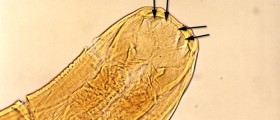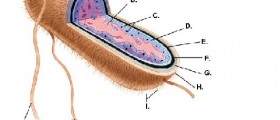
It is not certain for how long the tapeworms have been associated with humans, but it is probable that the relationship started once humans started eating meat of dead animals and later when they started keeping the livestock.
It does not really matter because even today people still occasionally suffer from hosting this parasitic organism. What are tapeworms?
Tapeworms are parasites of the Cestoda family. There are several varieties of human tapeworms, like Taenia solium, Taenia saginata, Echinococcus granulosus, Hymenolepsis nana.
The beef tapeworm or Taenia saginata is the most commonly found tapeworm in North America, while in Latin America Taenia solium or pork tapeworm is more common.
Tapeworms have a flat, segmented body and they can range in length from six inches to as much as 26 feet. The head of this parasite attaches to the walls of the intestines and feeds, and the body segments release eggs that attach themselves elsewhere. Most of them have both male and female body types and they can fertilize their own eggs.
How are tapeworms spread?
After reproduction, the eggs of tapeworms develop into embryos, which exit the digestive system and seek for the nearest source of water. The embryos can be ingested through direct contact with infected feces, by drinking the contaminated water or eating contaminated meat or fish.
Embryos do not instantly turn into adult tapeworms. They can drill and travel the bloodstream until they find a perfect place to dwell, surrounded in a sac or a cyst. This can be very dangerous, for example if the embryo is settled in the central nervous system.
What are the symptoms of tapeworms?
The tapeworm infection is often asymptomatic, with no precise or pronounced symptoms. If symptoms do occur, they are usually misinterpreted as irritable bowel syndrome, upset stomach or stress, because they include constipation, stomachache, diarrhea and discomfort in the abdomen. Most tapeworm victims realize they are infected only after seeing headless tapeworm bodies in their stool.
What is the treatment for tapeworms?
The hardest part is to diagnose tapeworm properly. Once it is done and the tapeworm infection is confirmed, there is a wide array of conventional and naturopathic medications that can be used.
A good colon cleansing program is often very effective. As for the conventional treatment, niclosamide or quinacrine hydrochloride are usually prescribed to kill the parasite which can then be removed from the body via bowel movement. Albendazole and prazinquantel are two drugs used to kill the embryos. These drugs often have significant side effects and should be taken only under medical supervision.






_f_280x120.jpg)










Your thoughts on this
Loading...